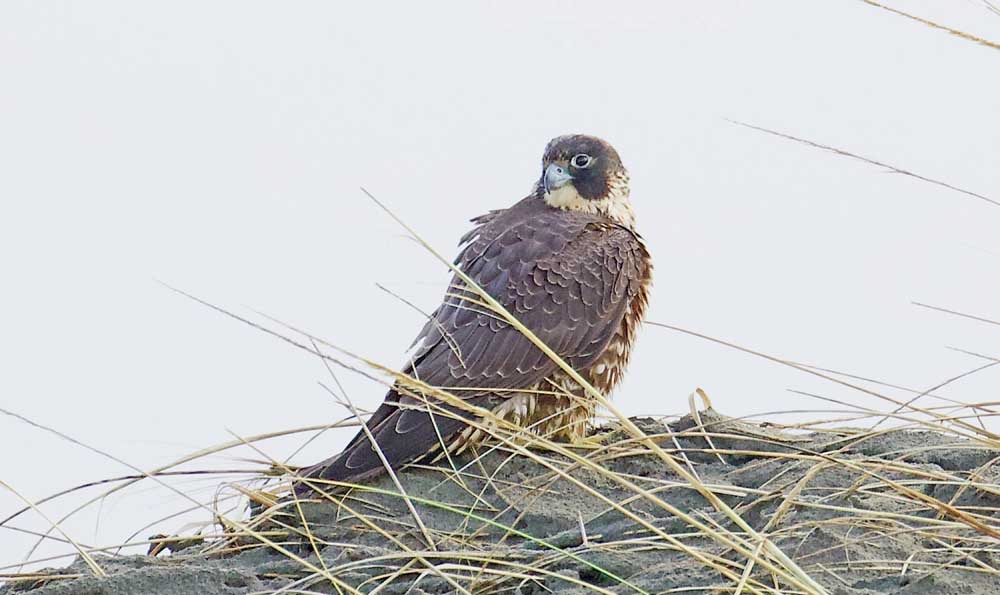Birding: Now’s a good time for hawk/raptor watching
Published 10:59 am Friday, September 8, 2023

- Peregrine falcons will soon migrate to the Peninsula. They are fast flyers with long pointed wings. One of the best places to look for them is on our beaches.
Hawk flights can be big and when they are, they are impressive. At this time of year birders flock to the best “hawk” migration sights North America with the hope of witnessing “a big day.”
Trending
Hawks can fly very high in the air overhead, but expert birders can easily identify these high in the sky specks. I think the reason for this activity being called hawk watching, even though it includes watching all raptors, is that the largest flights will be of hawks. Many thousands of hawks can be counted or observed on “a big day.” Other raptors are usually seen in much smaller numbers.
Raptors can be categorized into groups such as buteos, vultures, kites, accipiters, eagles, osprey, and falcons. Note that birds in some of these categories are referred to as hawks (red-tailed hawk, rough-legged hawk) which are raptors, while others like eagles, are not called hawks but are referred to as raptors. In other words, all the categories mentioned above fall under the title of raptors.
There are a few helpful keys to the identification of hawks and raptors as they are also called. Visiting sites where raptors congregate are useful. There we could see many different species of raptors and often during a day or two. This makes for good practice with the identification of hawks. Crossley (2013) argues that any characteristic that helps identify a bird is a field mark. Size, shape, vocalization, behavior, habitat, coloring (markings or patterns), and range are among the best field marks for all bird species.
Trending
Each group has a distinct shape and size, so it seems like a good place to begin. Buteos, for example, have broad, rounded wings and falcons generally have long pointed wings. The bald eagle is very large bird. Vultures have bare skin on their heads. A case in point is our summer resident turkey vulture which has a face and head that is red skin.
A raptor’s tail shape and size can also be a useful ID marker along with other characteristics. Tails can be long, short, rounded, or squared. Some tails are notched. Wings have their own character too. They can be rounded like that of the red-tailed hawk or pointed like that of the peregrine. Speedy fliers like the peregrine usually have pointed wings. Osprey wings look as though they have fingers at the ends that have been dipped in black ink.
One hawk that fits into a category called “Other” is the northern harrier. It tends to fly low when hunting over fields, marshes, and other wetland areas. It is a glider with very long wings and tail. Males are a light gray in color, while the female is brown. An important ID marker is their white rump.
Field guides are a useful tool for learning the best marker IDs for hawks and other raptors, and there are specialty books such as Crossley’s book on raptor ID. A careful look at “The Crossley Guide: Raptors” (2013) is an invaluable resource for seeing hawks or other raptors in various flight and sitting positions. Other field guides for the birds of North America such as Peterson’s guide (2020) and Sibley’s second edition (2013) are also excellent ID resources. However, seeing the same birds over and over is an excellent way to improve ID learning. It is also good ID practice.
Hawks prefer not to cross large bodies of water so that certain sites along the shoreline of lakes such as the great lakes, the Atlantic Ocean and the Pacific Ocean are great vantage points from which to witness the migration of North American raptors. Hawks also concentrate along mountain ranges such as the Rockies. In California, for example, Hawk Hill, located in the Golden Gate National Recreation Area is an excellent place for viewing hawks during migration.
The optimum time for hawk watching here and from most hawk watching sites in the USA is from September to November. Hawk watching includes seeing and watching eagles, vultures, osprey, and kites etc., whether they are in flight or congregating on land. Raptor watching right here on the peninsula is excellent. Look for them on the beach, on the Willapa National Wildlife Refuge or Cape D.
November marks the beginning of the winter raptor survey sponsored by Audubon. This year celebrates its 20th year. I am looking forward to participating in the survey again this year. It is a very exciting and worth-while enterprise. It is citizen science at its best. Happy birding.









